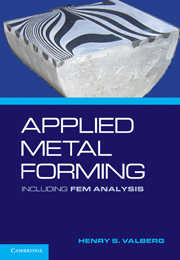Book contents
- Frontmatter
- Contents
- Preface
- APPLIED METAL FORMING
- 1 Characteristics of Metal Forming
- 2 Important Metal Forming Processes
- 3 FEA of Metal Forming
- 4 Theory
- 5 Reduction and Proportions of the Plastic Zone
- 6 Deformations from the Velocity Field
- 7 Technological Tests and Physical Simulation
- 8 Flow Stress Data
- 9 Formability and Workability
- 10 Friction and Friction Models
- 11 Thermal Effects
- 12 Experimental Metal Flow Analysis
- 13 Theoretical Methods of Analysis
- 14 Finite Element Analysis
- 15 FEA of Technological Tests
- 16 Forging
- 17 FEA of Forging
- 18 Extrusion
- 19 FEA of Extrusion
- 20 Rolling
- 21 FEA of Rolling
- 22 Drawing of Wire, Profiles, and Tubes
- 23 FEA of Wiredrawing
- 24 Sheet-Metal Forming
- Index
- References
12 - Experimental Metal Flow Analysis
Published online by Cambridge University Press: 05 June 2012
- Frontmatter
- Contents
- Preface
- APPLIED METAL FORMING
- 1 Characteristics of Metal Forming
- 2 Important Metal Forming Processes
- 3 FEA of Metal Forming
- 4 Theory
- 5 Reduction and Proportions of the Plastic Zone
- 6 Deformations from the Velocity Field
- 7 Technological Tests and Physical Simulation
- 8 Flow Stress Data
- 9 Formability and Workability
- 10 Friction and Friction Models
- 11 Thermal Effects
- 12 Experimental Metal Flow Analysis
- 13 Theoretical Methods of Analysis
- 14 Finite Element Analysis
- 15 FEA of Technological Tests
- 16 Forging
- 17 FEA of Forging
- 18 Extrusion
- 19 FEA of Extrusion
- 20 Rolling
- 21 FEA of Rolling
- 22 Drawing of Wire, Profiles, and Tubes
- 23 FEA of Wiredrawing
- 24 Sheet-Metal Forming
- Index
- References
Summary
In this chapter, the principles of metal flow analysis will be discussed, with particular emphasis on use of stripe or line patterns, made of contrast material, to map metal flow in hot aluminum extrusion. Emphasis will also be on use of ring patterns on the surface of workpieces to trace friction-dependent metal flow against die surfaces.
Grid Pattern Techniques Used to Trace Metal Flow
Grid pattern analysis was developed as a tool for understanding different metal flow phenomena encountered in metal forming processes. In the beginning, it was common to use model materials, such as Plasticine or clays, to imitate metal flow. These model materials have deformation characteristics similar to metals, and thus can be used to reproduce the real metal flow conditions with good similarity, when chosen appropriately. Such materials require only low loads in forming, and therefore their flow could be studied visually through glass plates in order to determine the main factors affecting metal flow. Grid patterns were also added on the surface of the model materials, or to their interior, to study material flow, as for metals.
Typical flow-related defects were observed to occur on various occasions; for instance, pipe formation can appear in the rear end of an extrusion. That some of these defects are related to the nature of the metal flow in the process was discovered through the use of grid pattern techniques.
- Type
- Chapter
- Information
- Applied Metal FormingIncluding FEM Analysis, pp. 181 - 203Publisher: Cambridge University PressPrint publication year: 2010
References
- 1
- Cited by



